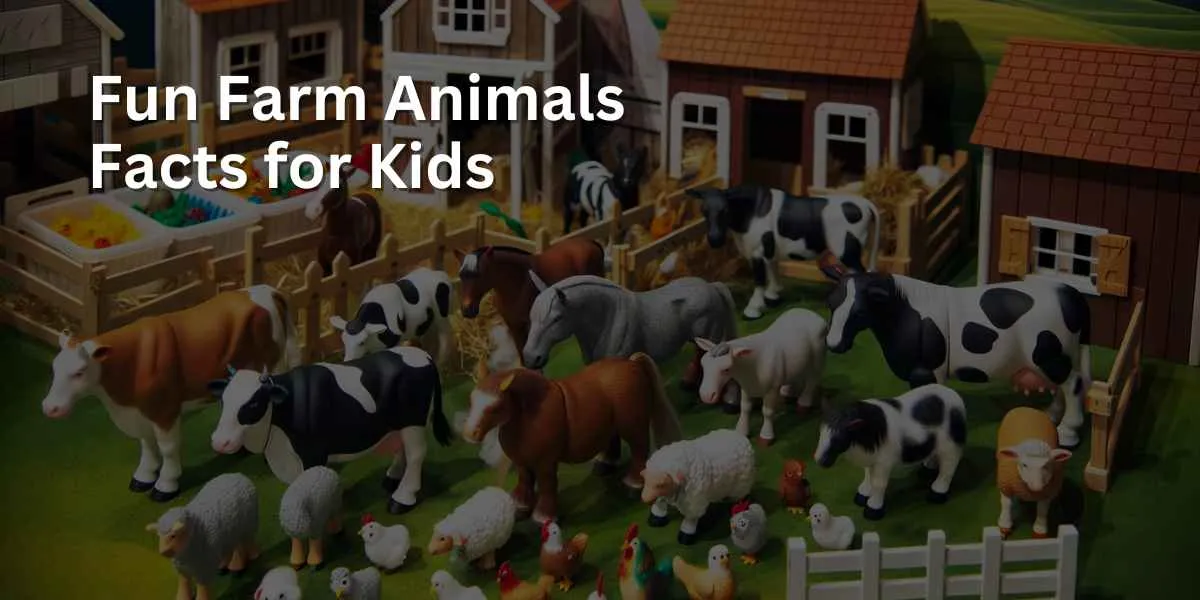Many children will not become farmers when they grow up but they love to role-play as farmers. Toys like wooden farm sets which come with farm animals, barns and stables make your child’s pretend play more realistic and fun. To make it more exciting and educational, you can tell your kid some fun facts about farming while she’s playing with her toys.
We’ve made a list of fun facts that you can tell to your children to expand their knowledge about farms and farm animals.
Quick Summary Facts about Farm Animals
| Farm Animal | Fun Facts |
|---|---|
| Cows | – Cows have four stomachs to help them digest their food. – They can sleep standing up but prefer to lie down. – A cow can produce around 6 to 7 gallons of milk per day. |
| Pigs | – Pigs are very intelligent animal and can learn tricks just like dogs. – They love to roll in mud to keep cool because they don’t have sweat glands like humans. – A pig’s snout is very sensitive and strong, which helps them dig in the soil for food. |
| Chickens | – Chickens have great memories and can recognize over 100 different faces. – They love to take dust baths to keep clean and free of pests. – Hens (female chickens) can lay over 300 eggs per year. |
| Sheep | – Sheep have excellent peripheral vision, with a field of vision of around 300 degrees. – They prefer to stay in groups as a way to protect themselves from predators. – Their woolly coats help keep them warm in winter and cool in summer. |
| Horses | – Horses can sleep both standing up and lying down. – They have a large range of facial expressions that help them communicate. – Horses have the largest eyes of any land mammal. |
| Goats | – Wild Goats are great climbers and can climb steep, rocky terrains with ease to eat food. – They have rectangular pupils which allow them to have a wide field of vision. – Goats are known to be curious and intelligent animals. |
| Ducks | – Ducks have waterproof feathers unlike other farm animals, which keep them dry while swimming. – They have excellent vision, seeing in color and having a nearly 340-degree field of vision. – Ducklings are able to walk and swim shortly after hatching. |
| Turkeys | – Wild turkeys can run up to 25 miles per hour and fly as fast as 55 miles per hour. – They have excellent hearing, but no external ears. – Male turkeys (toms) gobble to attract female turkeys (hens), who respond with clucking sounds. |
Cows
- Cows have a sense of smell that is better than a dog’s.
- They have four stomachs and can digest their food for up to 8 hours.
- Cows can walk up stairs but cannot walk down them due to their anatomy.
- The oldest cow ever recorded was named “Big Bertha” and lived until the age of 48.
- Cows are social animals and have best friends within their herd.
- They can produce up to 200,000 glasses of milk in their lifetime.
- Cows have an excellent memory and can remember faces for years.
- The spots on cows are unique to each individual and are like their fingerprints.
- Cows can recognize up to 100 different individuals within their herd.
- They have a natural sunscreen in their skin that protects them from sunburn.
Goats
- Goats are social animals and can form close bonds with humans and other animals.
- They have rectangular pupils, which give them excellent peripheral vision.
- Goats are known for their agility and can climb steep mountains and trees.
- Female goats are called does, while male goats are called bucks.
- Goats are ruminants, which means they have a four-chamber stomach that allows them to digest tough plants.
- They have an excellent sense of balance and can even sleep standing up.
- Goats have a unique vocalization system and can communicate with over 20 different sounds.
- They have a lifespan of 10-15 years, but can live longer with proper care.
- Goats have been used for their milk, meat, and fiber for thousands of years.
- They have rectangular-shaped pupils that give them excellent peripheral vision, and their eyes can see up to 320 degrees without turning their heads.
Chickens
- Chickens can see in color and have a much wider range of vision than humans.
- They have excellent memories and can recognize up to 100 different individuals.
- Chickens have their own language and communicate with each other using over 30 different sounds.
- They have a special gland near their tail feathers that produces oil to keep their feathers waterproof.
- A group of chickens is called a “flock” or “clutch”.
- Hens can lay eggs without a rooster, but the eggs will not be fertilized.
- Chickens are omnivores and will eat almost anything, including small insects and even small mice.
- They have a unique way of cooling themselves down called “panting”, where they breathe rapidly to release heat.
- Chickens can live for up to 10 years.
- Roosters have a unique crow that is different from other roosters.
Pigs
- Pigs are very intelligent animals and can be trained to perform tasks, like dogs.
- They are social animals and prefer to live in groups.
- Pigs have a strong sense of smell and can be used to detect things like truffles and bombs.
- They have excellent memories and can remember things for years.
- Pigs are very clean animals and will not defecate in the same area where they sleep.
- Piglets learn to recognize their mother’s voice while they are still in the womb.
- They are very fast runners and can run at speeds up to 11 miles per hour.
- Pigs have very few sweat glands and have to roll in mud to cool themselves down.
- They are very sensitive animals and can become emotionally attached to other pigs or even humans.
- Pigs have a great sense of direction and can find their way home from long distances.
Donkeys
- Donkeys are members of the horse family.
- They were domesticated around 3000 BC in Egypt and have been used as working animals ever since.
- Donkeys have a great sense of memory and can recognize other donkeys and humans for many years.
- They are known for their strong, sturdy bodies and can carry heavy loads.
- Donkeys have a distinct braying sound which can be heard from up to 3 km away.
- They have a great sense of hearing and can rotate their ears 180 degrees to pick up sounds from all directions.
- Donkeys are social animals and prefer to live in herds.
- They have a keen sense of smell and can detect odors up to 100 meters away.
- Donkeys have a special relationship with horses and can act as companions or guardians for them.
- They are often used as therapy animals due to their gentle nature and calming presence.
Horses
- Horses can sleep standing up or lying down.
- They have a special stomach that allows them to digest roughage like hay and grass.
- Horses have a natural flight instinct and will run away from danger.
- They have very powerful legs and can run at speeds up to 55 miles per hour.
- A horse’s teeth never stop growing throughout their lifetime.
- Horses can communicate with each other through body language and vocalizations.
- They have excellent memories and can remember things for years.
- Horses have a unique digestive system where food passes through their system quickly.
- They are social animals and prefer to live in herds.
- Horses have a great sense of balance and can stand on three legs for long periods of time.
Sheep
- Sheep have excellent memories and can remember other sheep and humans for years.
- They have a field of vision of around 300 degrees, which helps them keep an eye out for predators.
- Sheep can recognize up to 50 different faces of other sheep and humans, and even distinguish emotions.
- The domestication of sheep dates back over 10,000 years to the Middle East.
- Sheep are social animals and prefer to live in groups, called flocks.
- The fleece of sheep is the most widely used natural fiber in the world.
- There are over 1 billion sheep in the world, making them one of the most numerous domesticated animals.
- Sheep have a unique digestive system that allows them to digest tough plants and vegetation.
- Some breeds of sheep have impressive horns, such as the Jacob Sheep, which can have up to 6 horns.
- Sheep have been used for more than just their wool and meat, with their milk being used to make cheese, yogurt, and other dairy products.
Geese
- Geese have a unique method of communication – they honk to keep in touch with one another.
- Domesticated geese are often raised for their eggs and meat, while wild geese are migratory birds.
- They have a unique visual system that allows them to see a 360-degree view of their surroundings without moving their head.
- Geese can live up to 20 years in the wild and 25 years in captivity.
- They have a strong instinct to protect their young and will fiercely defend their nests and goslings.
- Geese are intelligent birds and can remember human faces and voices.
- The ancient Egyptians considered geese to be sacred and often depicted them in their art.
- Some species of geese are able to fly at high altitudes, reaching heights of up to 29,000 feet.
- Geese are social animals and often mate for life, forming strong bonds with their partners.
- Some cultures consider geese to be symbols of loyalty and guardianship, while others view them as symbols of stubbornness and foolishness.
These are only a few fun facts about farm animals that you can share with your child. Teaching your children about farm life and farm animals can set them up for a better future.
Why is learning about farming important?
Learning about farming is important for several reasons. Firstly, agriculture is the foundation of our food system and provides us with the essential nutrients that we need to survive. By understanding how food is grown and where it comes from, we can make more informed choices about what we eat and support sustainable farming practices.
Additionally, farming plays a vital role in the economy and job market. Farmers and other agricultural workers produce crops and livestock that are sold locally and exported to other countries. They also contribute to the manufacturing and transportation industries by providing raw materials and goods for processing and shipping.
Furthermore, learning about farming helps us appreciate the importance of the environment and the impact that human activity has on it. Sustainable farming practices promote soil health, biodiversity, and natural resource conservation. By understanding the impact of agriculture on the environment, we can make more responsible decisions and support efforts to reduce our ecological footprint.
Finally, learning about farming can help us connect with our heritage and cultural traditions. Farming has been a part of human society for thousands of years, and many communities and cultures have deep roots in agricultural practices. By understanding our agricultural history and heritage, we can gain a greater appreciation for our roots and the importance of preserving our farming traditions.
Overall, learning about farming is crucial for understanding the importance of agriculture in our lives and its impact on our environment, economy, and cultural heritage.
What can children learn from leanring about animals?
Learning about animals can provide children with a wide range of benefits, both educationally and emotionally. Here are some things children can learn from learning about animals:
- Scientific concepts: Learning about animal biology, anatomy, and physiology can help children understand concepts such as adaptation, nutrition, and reproduction.
- Responsibility: Caring for animals teaches children about responsibility, empathy, and the importance of providing proper care for living creatures.
- Environmental awareness: Children can learn about the natural world and how humans impact it through studying animals and their habitats.
- Social skills: Working with animals can help children develop communication, teamwork, and problem-solving skills.
- Emotional intelligence: Children can learn to recognize and manage their emotions while interacting with animals, which can lead to improved emotional regulation and empathy.
- Cultural understanding: Learning about the roles that animals have played in different cultures can provide children with a deeper understanding of diverse perspectives and customs.
Overall, learning about animals can offer children a range of benefits that extend beyond basic knowledge of the animal kingdom.




